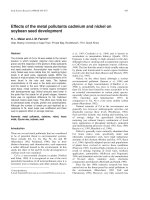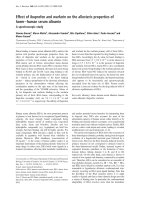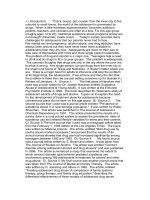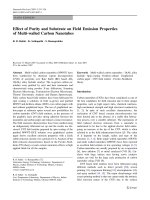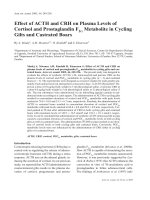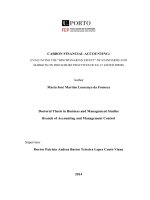effect of drugs and alcohol on teenagers
Bạn đang xem bản rút gọn của tài liệu. Xem và tải ngay bản đầy đủ của tài liệu tại đây (34.44 KB, 3 trang )
I.) Introduction: "Crack, booze, pot, crystal- from the inner city to the
suburbs to small towns, the world of the adolescent is permeated by
drugs. When 'a little harmless experimentation' becomes addiction,
parents, teachers, and clinicians are often at a loss. For this age group
(roughly ages 13 to 23), traditional substance abuse programs simply are
not enough" (Nowinski, inside cover). Today's society provides many
challenges for adolescents that our parents never had to face.
Pre-marital sex and pregnancy, alcohol abuse, and drug addiction have
always been around but they have never been more available to
adolescents than they are now. Adolescents are more on their own to
take care of themselves with more and more single parent households.
The problem of drug and alcohol is a major one. Teenagers feel a need
to drink and do drugs to fit in to peer groups. The problem is widespread.
The common thoughts that drugs are only in the city where the poor live
but that is wrong. Any single person can get drugs from the inner city to
the small rural towns of Texas and Nebraska. It doesn't matter where you
are. There is a major need for adults to intervene and stop the problem
at its beginnings, the adolescents. If we sit here and deny the fact that
the problem is there then we are just setting ourselves up for disaster.II.)
Review of Literature: A Source 1: The first piece of literature that I
used was a book written by Dr. Joseph Nowinski entitled Substance
Abuse in Adolescents & Young Adults. It was written at the Elmcrest
Psychiatric Institute in 1990. The book described Dr. Nowinski's study of
adolescent addicts of drugs and alcohol. It goes on to explain the need
for the development of treatment plans for adolescents because
conventional plans do not work on this age group. B) Source 2: The
second source that I used was a journal article entitled "Prevalence of
substance abuse in a rural teenage population." It was written by Wade
Silverman. This article was published in The Journal of Adolescent
Chemical Dependency in 1991. This article presented the results of a
survey done in a rural school system to assess the prevalence rates of
substance use and related lifestyle variables for teens and their parents.
C) Source 3:The third source that I used was a newspaper article taken
from the February 1, 1994 edition of the Los Angeles Times. The piece
was written by Marlene Cimons. The article, entitled "Illicit drug use by
youths shows marked increases," announced that the results of an
annual survey showed that drug use had increased significantly among
teenagers between 1992 and 1993. D) Source 4: My fourth source
was a journal article written by S. Brown and others. It was taken from
The Journal of Studies on Alcohol. The article was entitled "Conduct
disorder among adolescent alcohol and drug abusers" and was published
in 1996. The article summarized a study that examined the extent to
which conduct disorder type behavior predated substance use
involvement among 166 adolescents in treatment for alcohol and other
drug abuse. E) Source 5: My final source was another journal article that
was taken from The Journal of Marital and family Therapy. The article
was written by H. Joanning and others in 1992. The article, entitled
"Treating adolescent drug abuse: A comparison of family systems
therapy, group therapy, and family drug education," describes the
differential effectiveness of three models of adolescent drug abuse
treatment. It compares the Family Systems Therapy, the Adolescent
Group Therapy, and the Family Drug Education models.III.) Methodology:
I started out my research by going to the computers in the library
and researching journal and newspaper articles in the WinSpirs
databases. I found articles from psychology, sociology, and science
databases. I then looked for the articles in the journal section of the
library. I found some of the articles in the school library as well as using
my local library. I also used the OPAC computer to find my book
source.IV.) Result of Information Gathered: A) Source 1: Dr.
Nowinski's book describes specific cases of adolescent drug abuse that
he has worked with. He describes the different patterns of drug abuse
and the causes of such abuse. He describes causes like alienation, low
self- esteem and confidence, stress, and peer pressure. He goes into
how development of new treatment techniques are necessary because
adolescent addictions are different than those of adults. He describes the
process of counseling, denial and compliance, and surrender and
recovery. Nowinski stresses the need for family intervention in cases that
involve adolescents. B) Source 2: Silverman gives the results of the
survey and attempts to interpret the results. It was found that 83% of the
students in the study were either abstainers or experimental users. It was
recommended that primary prevention strategies should be used with this
group. The remaining 17% had been deemed "drug users" and it was
found that they all shared a similar lifestyle. All had multiple substance
abuse problems, were engaged in frequent sexual activity, and received
poor grades. it was also found that the amount of parental attention and
supervision was significantly different for both groups. C) Source 3:
This article said that the rise in drug use among teens was driven
by a dramatic rise in the use of marijuana and more use of stimulants,
LSD and inhalants. It also describes how this trend was a reversal from
the recent downward patterns of drug use among teens. D) Source 4:
It was found that most cases of alcohol and drug abuse in
adolescents was attributed to conduct disorder behavior. It was also
found that cases involving this disorder and drug abuse led to a more
frequent relapse into the problem and an increase in anti-social
behavior.E) Source 5: This study found that the Family Therapy
Systems model of treatment appeared to be more effective in treating
and stopping adolescent drug abuse. It registered twice as many
drug-free clients as the Family Drug Education program and three times
as many as the Adolescent Group Therapy model.V.) Summary and
Conclusion: Through the literature and the class it is obvious that drug
and alcohol abuse among adolescents is a prevalent and dangerous
problem. The use of these substances is dangerous and stupid. I'm not
going to be a hypocrite and say that I have never tried any drugs or
alcohol. I'd be lying if I said that I haven't but now I realize that it is a
problem that has to be addressed through action and not ignorance.Table
of ContentsI.) Introduction 1II.)
Review of Literature 2 A) Source 1
2 B) Source 2
2 C) Source 3
3 D) Source 4
3 E) Source 5
3III.) Methodology
4IV.) Results of Information
Gathered 4 A) Source 1
4 B) Source 2
5 C) Source 3
5 D) Source 4
6 E) Source 5
6V.) Summary and Conclusion
6ReferencesBrown, S. "Conduct disorders
among adolescent alcohol and drug abusers." Journal of Studies on
Alcohol. Psychological Service, Veterans Affairs Medical Center. San
Diego. 1996.Cimons, M. "Illicit drug use by youths shows marked
increase." Los Angeles Times. February 1, 1994. Sec:A, p:1,
col:6.Joanning, H. et al. "Treating adolescent drug abuse: A comparison
of family systems therapy, group therapy, and family drug
education." The Journal of Marital and Family Therapy. October,
1992.Nowinski, Joseph. Substance Abuse in Adolescents and Young
Adults. W. W. Norton & Company Ltd. New York. 1990.Silverman,
Wade. "Prevalence of substance abuse in a rural teenage population."
The Journal of Adolescent Chemical Dependency. Volume 2. 1991.
